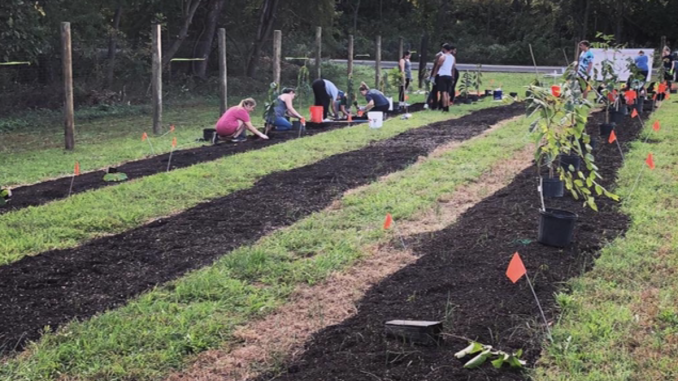
Evan Stinson (evstinson@ursinus.edu)
A “Welcome to Your Food Forest” banner sat in front of the rows of trees and busy volunteers digging through mulch and clay. Just like anything else, trees need space to grow, and that meant digging wider holes than one would expect. The hard work of the volunteers and members of the Environmental Studies Capstone made possible a home for 92 new trees on Friday October 8th and Saturday October 9th on the campus Food Forest.
The project was organized by the Chair of the Environmental Studies Department, Patrick Hurley, who also oversaw the original Food Forest planting in Fall 2019. “The idea was to develop a site for experiential and experimental learning around agroecology, or agriculture that is informed by ecological principles.” Imagining agricultural fields as really not so different from the ecosystems nearby can actually improve their food production and long-term sustainability.
Located at the corner of College Ave and 3rd Ave, the Food Forest and Dr. Denise Finney’s soil-carbon sequestration research fields share an eleven acre, former agricultural land called the Whittaker Environmental Research Station (WERS). WERS was originally purchased from Northern Star Dairy Farm with donations from alumni Donald and Andrew Whittaker as well as Elizbeth Magrann. Today, the Food Forest hosts an array of fruit- and nut-bearing trees standing between bright flowered plants with hints of mints. Monarch butterflies come for the milkweed; the future nurseries for their young. “This type of system is both new and old. It represents a combining of species in ways not typical of modern farming systems,” Hurley commented. These methods have been practiced among different indigenous peoples for centuries across continents, including those who inhabited Southeastern Pennsylvania: the Lenape. The indigenous people in our region would eat a fruit planted in huge quantities during this phase — the pawpaw — around early fall. At the Food Forest, nearly 80 of the “mango-avocado” flavored fruit were settled in the ground. Hurley pointed out that out of these 80, 60 of the trees came from a handful of sources that have been artificially selected for consistency in flavor. This with the ideal goal of eventually students and the local community getting to enjoy these fruits every year around late August. These pawpaws are only phase one of two for the Food Forest, which concluded with a second round of planting. Another 160 trees were planted for this next piece including black aronia berry, Allegheny serviceberry, American persimmon, and sumac to name a few. “All of these species provide edible items, although these fruits are likely completely unfamiliar to most Ursinus students.” added Dr. Hurley. All these point towards creating a physical long-term beneficial impact on surrounding species and communities with positive effects for education, nutrition, and health for generations to come.
If interested in learning more about the forest or joining the volunteer outreach team, please contact foodforest@ursinus.edu.
